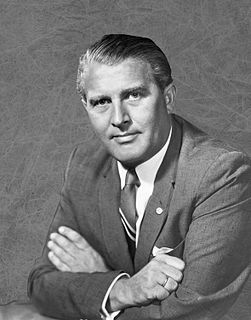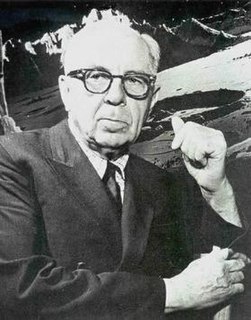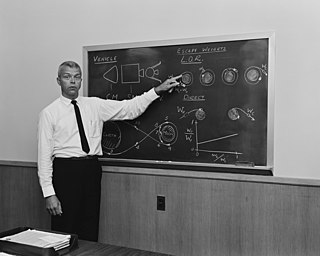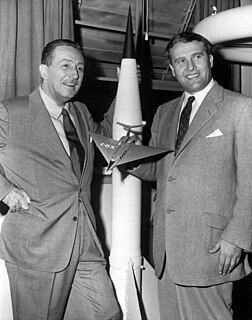Related Research Articles

Wernher Magnus Maximilian Freiherr von Braun was a German-American aerospace engineer and space architect. He was the leading figure in the development of rocket technology in Nazi Germany and a pioneer of rocket and space technology in the United States.

Hermann Julius Oberth was an Austro-Hungarian-born German physicist and engineer. He is considered one of the founding fathers of rocketry and astronautics, along with the French Robert Esnault-Pelterie, the Russian Konstantin Tsiolkovsky, and the American Robert Goddard.

Ward Walrath Kimball was an American animator employed by Walt Disney Animation Studios. He was part of Walt Disney's main team of animators, known collectively as Disney's Nine Old Men. His films have been honored with two Academy Awards for Best Animated Short Film.

Chesley Knight Bonestell Jr. was an American painter, designer and illustrator. His paintings inspired the American space program, and they have been influential in science fiction art and illustration. A pioneering creator of astronomical art, along with the French astronomer-artist Lucien Rudaux, Bonestell has been dubbed the "Father of Modern Space art".

Willy Otto Oskar Ley was a German-American science writer and proponent of cryptozoology. The crater Ley on the far side of the Moon is named in his honor.

The U.S. Space & Rocket Center in Huntsville, Alabama is a museum operated by the government of Alabama, showcasing rockets, achievements, and artifacts of the U.S. space program. Sometimes billed as "Earth's largest space museum", astronaut Owen Garriott described the place as, "a great way to learn about space in a town that has embraced the space program from the very beginning."

Conquest of Space is a 1955 American Technicolor science fiction film from Paramount Pictures, produced by George Pal, directed by Byron Haskin, that stars Walter Brooke, Eric Fleming, and Mickey Shaughnessy.
"Man Will Conquer Space Soon!" was the title of a famous series of 1950s magazine articles in Collier's detailing Wernher von Braun's plans for manned spaceflight. Edited by Cornelius Ryan, the individual articles were authored by such space notables of the time as Willy Ley, Fred Lawrence Whipple, Dr. Joseph Kaplan, Dr. Heinz Haber, and von Braun. The articles were illustrated with paintings and drawings by Chesley Bonestell, Fred Freeman, and Rolf Klep, some of the finest magazine illustrators of the time.

Space Race is a BBC docudrama series first shown in Britain on BBC2 between 14 September and 5 October 2005, chronicling the major events and characters in the American/Soviet space race up to the first landing of a man on the Moon. It focuses on Sergei Korolev, the Soviet chief rocket designer, and Wernher von Braun, his American counterpart. The series was a joint effort between British, German, American and Russian production teams.
"Man in Space" is an episode of the American television series Disneyland which originally aired on March 9, 1955. It was directed by Disney animator Ward Kimball. This Disneyland episode, was narrated partly by Kimball and also by such scientists Willy Ley, Heinz Haber, and Wernher von Braun; as well as Dick Tufeld of Lost in Space fame.

"Mars and Beyond" is an episode of Disneyland which aired on December 4, 1957. It was directed by Ward Kimball and narrated by Paul Frees. This episode discusses the possibility of life on other planets, especially Mars. The show was also released in theaters in 1957.

John Cornelius Houbolt was an aerospace engineer credited with leading the team behind the lunar orbit rendezvous (LOR) mission mode, a concept that was used to successfully land humans on the Moon and return them to Earth. This flight path was chosen for the Apollo program in July 1962. The critical decision to use LOR was viewed as vital to ensuring that man reached the Moon by the end of the decade as proposed by President John F. Kennedy. In the process, LOR saved time and billions of dollars by efficiently using the rocket and spacecraft technologies.

From 1955 through 1962, the TWA Moonliner was part of the first futuristic exhibit located in Disneyland's Tomorrowland. It was also an early example of modern product placement advertising by TWA's Howard Hughes teaming up with Walt Disney as the Moonliner's sponsor.

Ernst Stuhlinger was a German-American atomic, electrical, and rocket scientist. After being brought to the United States as part of Operation Paperclip, he developed guidance systems with Wernher von Braun's team for the US Army, and later was a scientist with NASA. He was also instrumental in the development of the ion engine for long-endurance space flight, and a wide variety of scientific experiments.
The third wave of Walt Disney Treasures was released on May 18, 2004. It was originally planned to be released in December 2003, but was delayed for almost half a year in order to meet an increased demand with a higher number of tins produced. This wave was the first to have a certificate of authenticity with the individual number of the tin on it, replacing the number embossed on the tin. This was the final wave released with side straps.
Apogee Books is an imprint of Canadian publishing house Collector's Guide Publishing. The Apogee imprint began with "Apollo 8 The NASA Mission Reports" in November 1998 at the request of astronaut Buzz Aldrin, second man on the moon. The first publication by Apogee was printed to celebrate the 30th anniversary of the first crewed flight around the moon. A limited edition print run of this Apollo 8 book led to Aldrin suggesting that the imprint continue with further anniversary publications.
Robert Godwin is a British author who has written about rock music and spaceflight. Early in his career he was a rock music impresario who managed a venue in Burlington, Ontario and founded Griffin Music.

The Mars Project is a 1952 non-fiction scientific book by the German rocket physicist, astronautics engineer and space architect, Wernher von Braun. It was translated from the original German by Henry J. White and first published in English by the University of Illinois Press in 1953.
Plymouth is a 1991 science fiction television film that was shown on ABC Network in the same year, as a pilot for a planned series. It was created by Lee David Zlotoff and funded by the American Broadcasting Corporation, Walt Disney and Rai uno radiotelevisione, with Lockheed acting as technical advisors.

A single-person spacecraft is a vehicle designed for space travel. The concept has been used in science fiction and actual ships such as the Mercury capsule, Vostok and some suborbital designs. Single-person spacecraft have been envisioned as a supplement or replacement for space suits in certain applications. The Von Braun Bottle suit of the 1950s functions as a hybrid of a space suit and a one-person spacecraft.
References
- 1 2 Cotter, Bill (1997). The Wonderful World of Disney Television. Hyperion Books. pp. 132, 536. ISBN 0-7868-6359-5.
- ↑ "Wernher von Braun". IMDb. Retrieved 17 August 2017.
- ↑ "Tomorrowland DVD Review". DVD Dizzy. Retrieved 14 February 2021.